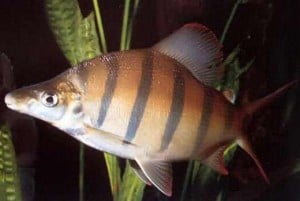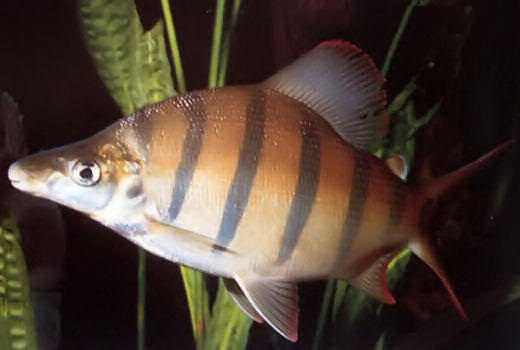
Common name: Long-nosed Distichodus
Scientific name: Distochodus Lusosso
Average Adult Fish Size: 15 inches / 37.5cm
Place of Origin: Rivers of Cameroon, Republic of Congo, Democratic Republic of Congo in Africa.
Typical Tank setup: Decorate with large rocks and large, smooth driftwood/bogwood pieces. It will readily devour most aquarium plants, but if live plants are a must use species such as Anubias or Bolbitis, as most fish leave these alone.
Recommended Minimum Aquarium Capacity: 100 gallon / 400 litre
Compatibility: The personality of Lusossos can vary greatly. They are best kept with fish that are not small enough to be eaten or bullied. This fish can definitely hold it’s own with most large and aggressive species if it decides to.
Temperature: 72 – 79 Deg F / 22 – 26 Deg C
Water chemistry: pH 6.5 – 7.5
Feeding: Large Lusosso will readily eat feeder fish, but this is not the best diet for them as the transmittance of disease is too great of a risk. It is best to feed them a varied diet of pellets and chunk frozen foods such as brine shrimp or beef heart. Earthworms, shelled mussels, and whole market shrimp are also relished. Plant matter should also be fed on a regular basis. Veggie pellets and wafers along with shelled green peas, blanched zucchini, and spinach are good choices for a Lusosso.
Sexing: Unknown
Breeding: Breeding has not been recorded in the hobby and this information is not available.
Additional Information: A little water flow is appreciated. It’s an excellent jumper, so the tank must have a tightly-fitting, heavy cover. One of only a handful of Distichodus are seen with any regularity in the hobby. This species is undeniable attractive when juvenile, but unfortunately loses much of its color and patterning as it matures. It is superficially similar to the more commonly seen D. sexfasciatus, but does not get as large. Frequent large water changes are a must as this fish is prone to eye fungus if nitrates get too high.


Related Posts
Croaking Gourami – Trichopsis vittatus
Benthochromis Tricoti
Large-eyed Mouthbrooder – Callochromis Macrops